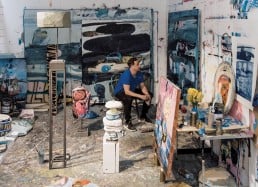
British artist Samuel Bassett is a man of the sea. His family has lived in St Ives, Cornwall since as far back as 1695, and the artist still lives and works there to this day. This rich heritage, and the dramatic natural surroundings, colour each work of art Bassett produces. His paintings are filled with arresting imagery and stories that seem to be written in a language that is very familiar, yet eludes conventional translation.
Samuel Bassett has had a steady trajectory at Anima Mundi gallery – with three previous solo exhibitions to his name there, he now presents his most mature show to date, ‘Hourglass’, on through June 1st 2019. ‘Hourglass’, in the words of Anima Mundi’s director Joseph Clarke, is a ‘laying to rest. It is an exhibition about time, loss, gain, love, the past, the future and the now. It is a love story to those who have left, those who are here and those who are next.’
With ‘Hourglass’, Samuel Bassett alternates between a cynical acceptance of the status quo and a deeply moving account of the human condition. For example, ‘Avocado Man Needs Tomato’ shows a man with a wry expression on his face and mockingly refers to the hipster food culture of our time, while ‘Bus to Tesco’ presents an almost underworld experience of an otherwise mundane bus ride to the supermarket. ‘On the Coffin Path’ is a more overtly serious and personal expression of death and loss. Here, a semi-translucent face cries yellow tears over a coffin carried away by a desolate group of figures. Bassett’s paintings have been described by Anima Mundi as ‘psychological cubism’, where the inner and outer self reveal themselves and coalesce.
On the occasion of his fourth solo exhibition at Anima Mundi, we spoke with the artist about this new body of work, his influences and inspirations.
"Just under the surface I shall be, all together at first, then separate and drift, through all the earth and perhaps in the end through a cliff into the sea, something of me." - Samuel Beckett
This is your fourth solo exhibition at Anima Mundi gallery. Could you share something with us about the development of this exhibition in comparison to the previous ones?
The first show I did there was my first solo show in a gallery, they represent a great selection of artists and I was so happy to be invited, but also so young. I wanted to literally install my entire studio with all its remnants in the gallery space, screwing paintings to the beams and packing the space full and also painting on the walls. The energy was great, but my inexperience may have resulted in a lack of restraint, which reflected the way I work in the studio but in retrospect it was far too much of an onslaught for the audience to fully take in.
Now though, I guess with a rise in my own confidence, I’m allowing each piece that leaves the studio its own space to breathe, in full confidence that it holds its own. The imagery has been changing too. It’s not just me, in various guises, feeling wrapped up in my own headspace. There is more of an exterior view in this exhibition, more landscape and more about place and history as a bridge forward. It’s more about US and not just about ME.
Your exhibition title, ‘Hourglass’, coupled with the Samuel Beckett quote introducing the exhibition, speaks very strongly of the inevitable passing of time and the passing of life. Could you elaborate a bit on your choice of these words?
I’ve been out a lot recently, on the hills on the edge of where I live. The granite tors here are amazing, protruding out of the top of the carnes, layers of rock, stacked, slipping and balancing. The character of these natural monuments has become a visual metaphor for the generations of people of these lands. The top layers are slowly eroding, wearing down and falling to the side, exposing the next.
A couple of months before the show, I lost both of my grandmothers within weeks of each other. It was powerful and strange and it heightened my anxieties, it was the loss and grief of an entire layer now missing from my day-to-day. But not just the people, the houses gone, the attachment to certain places gone, a way of life, the chain just snapping. My work is often about attachment to place and heritage, so it all came together in the making of this work and the spirit it contains. I feel sometimes that I wish I wasn’t so attached, I could be freer. But like everything, it’s a blessing and a curse, the work at least has deep roots.
The Samuel Beckett quote resonated with me deeply concerning my connection with my surroundings and how I feel about passing, and also with it comes a sense of hope in that things never leave, they become a part of all else – it’s almost Pagan! The fact we are here is bizarre eh, but, I like to think we just slip back into the land and then the sea and support the next layer to come forth. It’s poetic. I think ‘Hourglass’ describes the cycle well, layer upon layer and then repeat….
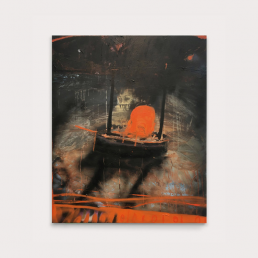
Joseph Clarke, the director of Anima Mundi, writes that your work is filled with a nostalgia and concerns for a way of life under threat, feelings that I think a lot of people in the 21st century can relate to strongly. Could you say something more about these feelings that imbue your artworks?
My own personal hopes and fears are, of course, unique to me but I think it’s a state that many others feel yeah. People at one time might have feared the industrial age and today, some have fears around the digital, some people are protective of certain ways of being or living, traditions etc. and some people seem less so. Is old knowledge important as we develop? What becomes lost in our quest for improvement? When we outgrow certain ways and certain knowledge becomes lost, are we becoming detached from our roots? These questions are ongoing… All development comes with pros and cons, my curse is to be preoccupied by that, and deeply concerned, but it’s also my job.
For me making work is finding a way to work through and learn from it. I’m only making this work whilst trying to work it out for myself. Life goes on despite our perceived fears and we will continue to be fearful each time the hourglass of life turns over. Importantly, I must admit also that I can be pretty optimistic and thoroughly enjoy my life, and this place so much too, you know. It’s all there in the work, in the details, to be seen when viewing the work closely. Life is a confusing hustle and bustle.
My work is very autobiographical, very associated with local issues and my own personal feelings about certain issues, but it’s also my little problems associating with a bigger problem, big or small, we’re all kind of going through those elements of loss and gain and I hope that’s readable, certainly feedback I get seems to suggest so.
You come from a very particular place in England, St Ives in Cornwall, where your family has lived for many generations. This area also has a strong heritage in British Modernism. I am interested to hear whether you relate to this lineage, and if so, how you position yourself in regards to it. Looking at your work, for example, I am sometimes reminded of the raw sweeping gestures of Peter Lanyon’s work.
I live in a small place, a coastal town, and it is now a successful tourist destination with a huge second home market. It wasn’t built on this though, instead it survived on its fishing and mining history. This is the heritage that I come from and my generation, in many families alongside my own, are not carrying on those jobs in these dying or threatened industries. We had other opportunities and I’m grateful for that, but as an affect the town has changed massively and quickly, ready to succeed in other areas but its former way of life is now gone and with it the loss of a certain character. Granite still stands but some of its heart and soul is now buried.
I didn’t get introduced to the British Modernists until later on. I didn’t have a family with any link to academic fine art so I didn’t really get to know about the Modernist artists until I was walking through town when I was in my teens and suddenly I saw these amazing paintings, collage and sculptures, in one gallery in particular, the Belgrave Gallery. Michael Gaca, the gallery Director, was really kind and would gift me catalogues when I was about 15. That was my introduction to Lanyon, Hepworth and Hilton who were gone long before my time but Frost, Bell and Heron were still around. I was young though and didn’t get to meet them although I did Trevor Bell as a fellow exhibitor at Anima Mundi. Tate St Ives was built here in 1993 but I never got taken there when I was younger, so it was foreign to me. My Grandad used to rent the net loft that sits below my studio complex, and that is where he would work, so now I feel very lucky to be where I am. I come from more of that lineage.
Who knows yet where I lie within the art history context from St Ives but I feel like I’m making more sense of it now and am proud to be sitting next to them artists in many private collections. In this exhibition, perhaps I am getting closer to them with many references that they made in their work. With my still life, landscape and constructed sculpture work being intertwined, it continues the methods that they worked with, but as emphasised with the themes of this show, time moves on and things change.
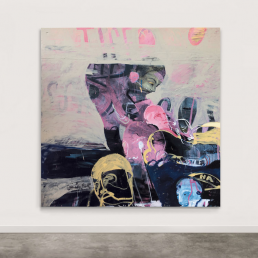
Could you speak some more about the influence of this setting on your work? The sea, the history of the region, seem to resonate strongly through your art, not least through your deeply affecting use of the colour blue.
I feel deeply invested into the region, personally and through my art, I suppose you paint what you know and that’s what I’m doing. I remember going to a friend’s house after school and having a really strong déjà vu, time and time again. When my Dad picked me up he said: “That’s where I grew up,” having lived there for a few years as a boy. Whilst looking out of the window of that house, I just knew that view and I knew the house. These things always get me thinking about lineage, and connection and stuff. I’ve painted that scene a lot now. Work in this show depicts remembered domestic scenes, views from the hills and imagined scenes of burning boats and memories of older fishermen now gone.
I tried to escape the blue, but it’s above me, beside me and beneath me and so it is in me. My studio is also next to the beach! Like the artists before, I’m definitely affected by the elements, the location, the pushing out into the big blue Atlantic. I tried to get away from the blues for a bit, just using a variety of blacks, pinks and reds, but I’ve revisited the colour, because it was right too.
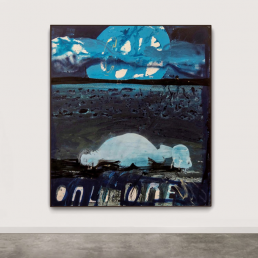
Could you elaborate on the different techniques and materials you work with?
When I started painting I used oils but soon switched to acrylics and inks, as it suited the speed of how I liked to work, and it allowed me to achieve layers and details quickly, matching the pace of my thinking and enabling me to get the more drawn elements into the work. I suppose my methods of working are broad, from concrete casts, ceramics through to mixed media sculpture and painting. I work with anything. I love playing with anything to hand or with new materials I discover.
As I say, I work in a lot of different ways depending on my mood. I can either sit still and focus on the more drawn aspects or I can go in and make up a couple of buckets of washes and then spend ten minutes just going for it and throw paint around and then I’m out again. Studio time is limited to the process that I’m using at that time, and my studio is relatively small so if I’ve filled everything then I may need to just go do something else for a while, and get out then return later to look again. I don’t sit in there and contemplate. I paint with bedsheets, pants, socks, whatever is to hand. It is immediate – I’ve lost many clothes to the making of art, haha. I’m never too prepared, I prefer hand to mouth making!
What does the practice of painting mean to you?
The act of painting is really important for me, the act of keeping busy and the act of just doing and discovering through painting and the use of materials. It’s a practical way of living and it allows me to work through and entertain my thought processes, my hands and my body. It’s almost a meditative process which allows an ability, a freedom and a route to discovery and communication whilst entertaining and educating the mind.
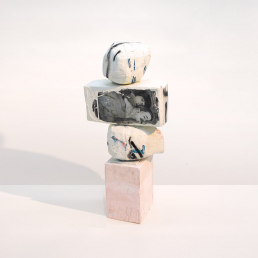
In this exhibition, you also include several sculptural pieces. What place do they take in your artistic practice?
I believe that they are a natural progression from using the materials and objects that I get and have in my studio. Plus, I always painted on board until recently and my paintings were quite collaged, assembled and sculptural themselves, so it’s just naturally progressed from the wall into a freestanding object as I progressed with my making. I’ve always made sculpture, it just goes hand in hand. I am working with some new contacts to realise larger sculptural works now though but I’m still trying to be as hands-on as I can.

I’m struck by the faces in your paintings. Nearly all of the works portray people with expressions that are quite haunting, for example in ‘Between us all’, ‘A gin and double tonic please’ and ‘Hahaha cold man’. Who are these people? Are they inspired by people you know, or are they strangers? How do you relate to them?
The people in the paintings are often an extension of people that I see in myself, so the paintings are always a kind of self-portrait. It’s like visualising my interior but then I’m definitely harvesting the people around me too, so the people in the pubs, studios or out on the beach… There are a lot of people who enter my range. They are people I see, people I meet blurred with inner voices and feelings. It’s a blurry line between the exterior and my interior.
‘A gin and double tonic’ pictures my partner, Ali, shouting for a drink in a crowded pub, the Golden Lion, a local of mine down St. Ives. Here the people are predominantly older men, a man from the lifeboat with a pipe, people shouting at the rugby and a reference to my Grandad, a fisherman with one of his paintings on the wall under the metal lion that sits on the wall in there. It’s a recording.
‘Between us all’ is like a cross-section, up under a granite up top, it’s made with faces that slip in and out of the background, ghosts, old carvings and artifacts, small fish between them like layers of sardines. They act as foundations, keeping the soil together.
‘HAHAHA Cold Man’ I made after a trip to Miami last year. It was nighttime on Ocean Drive. He turned and I just remembered that look. He’s framed by the lit-up palm trees across the road. I made two portraits of men there.
Looking at your paintings it becomes clear they are extremely layered – you often disrupt the more figurative elements with large sweeping strokes of paint. It’s as if you are trying to avoid anything looking too polished, too perfect. Could you reveal some of your thoughts behind this process?
I think the ability to hide and let the light shine through in painting is something I am really interested in. I take away as much as I apply so many layers come and go. I left many of these paintings alone at an earlier stage than normal, so perhaps they are more giving than they have been. I suppose I often obliterate more ‘finished’ elements. I don’t like going into a work with a fully formed idea but I always have images in my head. Once ideas are realised, maybe they feel too obvious, or they are a bit shit, or not like I thought they were going to be, not communicating as I wanted, so I destroy them either fully or partly. I like the studio practice to have its say, it’s a collaboration. I know sometimes I just want to eradicate bits because I like the process of destruction and maybe I’m hiding, hiding many thoughts but allowing some to be seen. The process is unguarded and guarded – that’s the human condition.
I feel it’s telling of my attitude towards painting and an insight into my personality I suppose rather than a thought-out way of working. Some days I can handle sitting carving or drawing for many hours, some days I make for a very short time using buckets of colour spread energetically with sheets or towels. Like life, I like variety and enjoy the extremes so I suppose I have a wide range of techniques. I love painting with layers, I like stuff with depth and maybe a kind of struggle. I’m exploring painting and painterly marks more and more.
You’ve said you like to work on several paintings at once. How do you go back and forth between them, and what’s going on in your mind while you’re figuring out the different processes in your canvases?
I feel it’s good to spread yourself which allows you to go in with a certain energy and if you want to go in with a particular action – it’s not going to work on everything that you make. So, it’s good to have many things on the go and plus I get very bored easily so if I’m bored with painting, I can go into concrete or drawing. I think to have many things on the go, allows you to spread marks and tones across works, so your developing those bodies of work in a unified way. Your constructing more of an interconnected language. Working on one thing feels so pressured, like all my eggs in one basket. I can work on a piece whilst others dry and some paintings are ready for a certain way of applying whilst others aren’t so it helps direct the mood I’m in… It just makes sense not to be waiting for stuff when I’m working.
Can you share something about the direction your work will be taking in the coming period?
I have a couple of things lined up and I’m always painting. I’m spending the summer just working but I am looking at residencies so I can travel somewhere else to work, to see how that will affect my work. I want to learn about other communities and cultures – I think this is something that’s important to me. So, I’m looking forward to spreading my wings a bit.
I am also working on some outdoor pieces for a client and I’m making some stop-motion and digital animations which I’m pretty excited about, particularly seeing my images move and the feelings I can portray that way. Basically, just continuing to look at other mediums to use. Painting is at the heart of what I do but looking in different directions and hoping to collaborate with other people. I’m still learning.
Thank you for your time Samuel!
Thank you so much! Until next time…
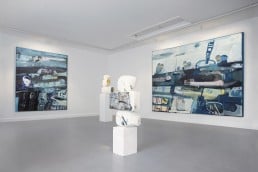
For more information about Samuel Bassett's work, visit:
Gallery
Anima Mundi
Opening Times
Mon – Sat
10 – 17
+44 (0) 1736 793121
Address
Street-an-Pol, St Ives, Cornwall, UK
TR26 2DS St Ives
United Kingdom




